
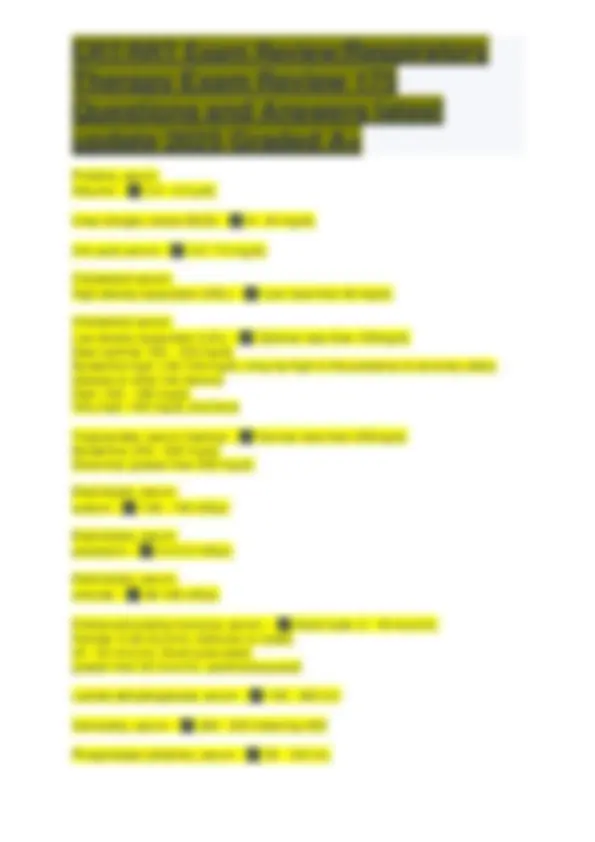
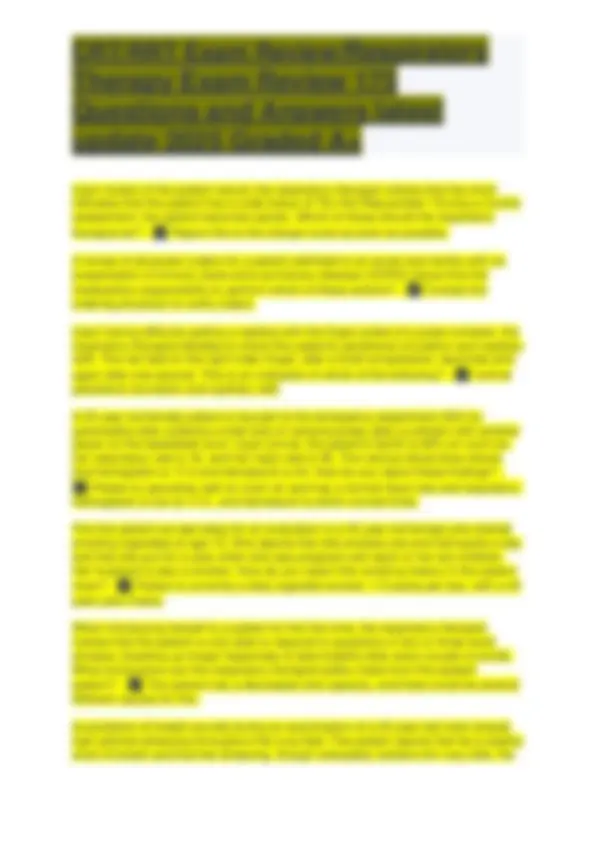
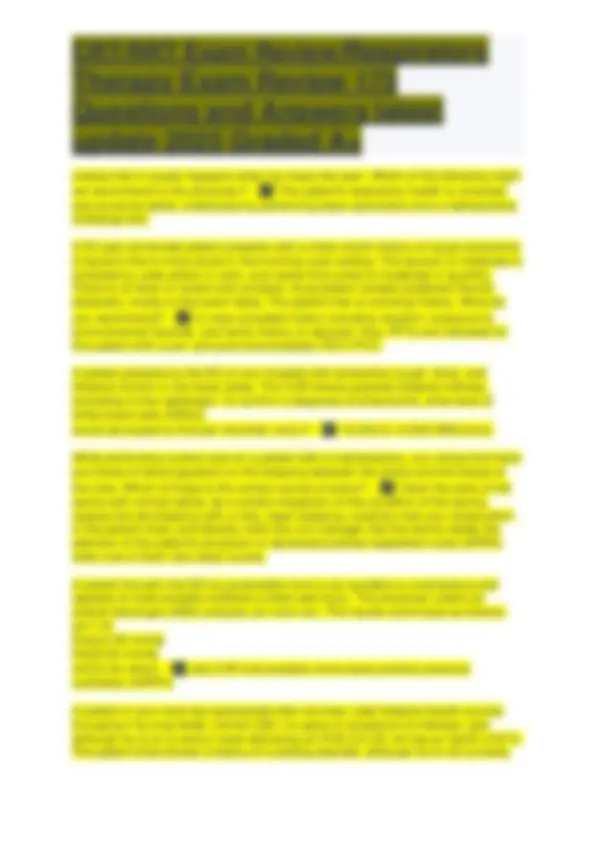
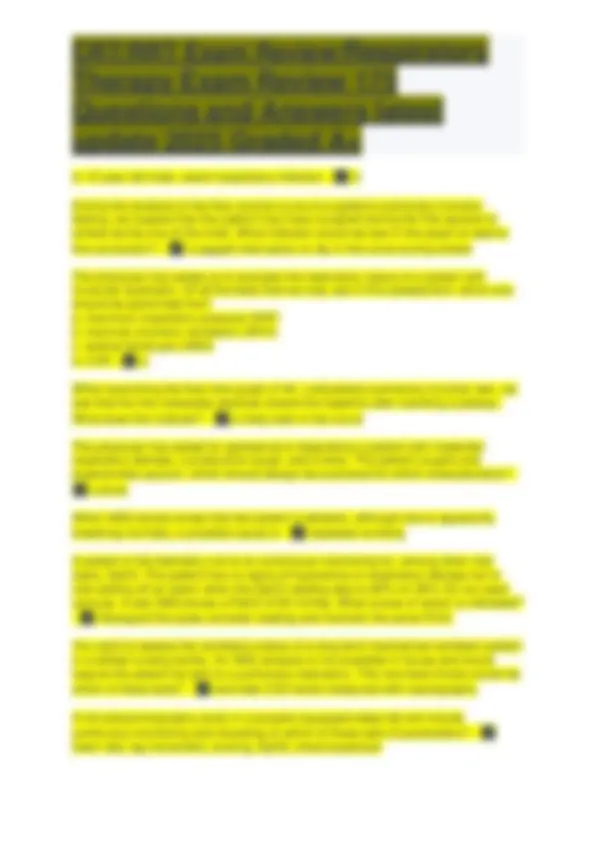
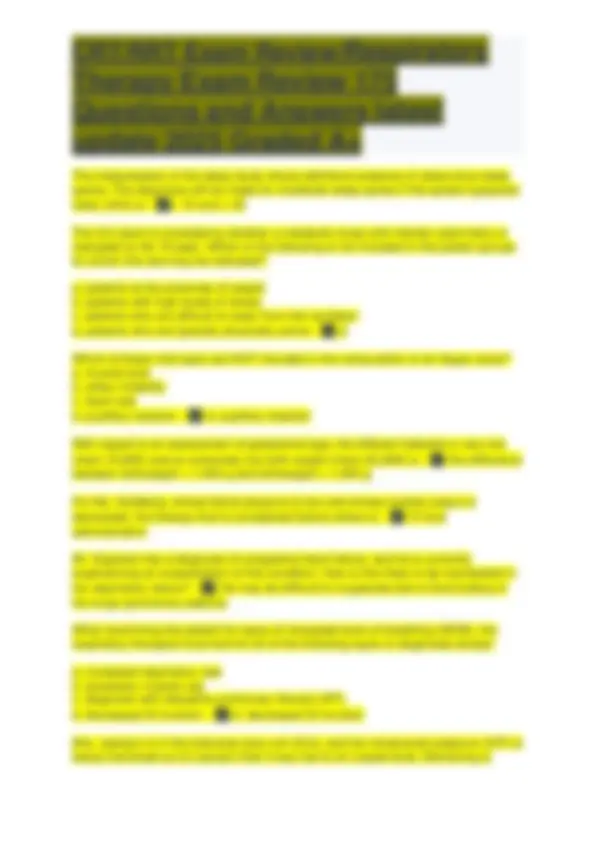
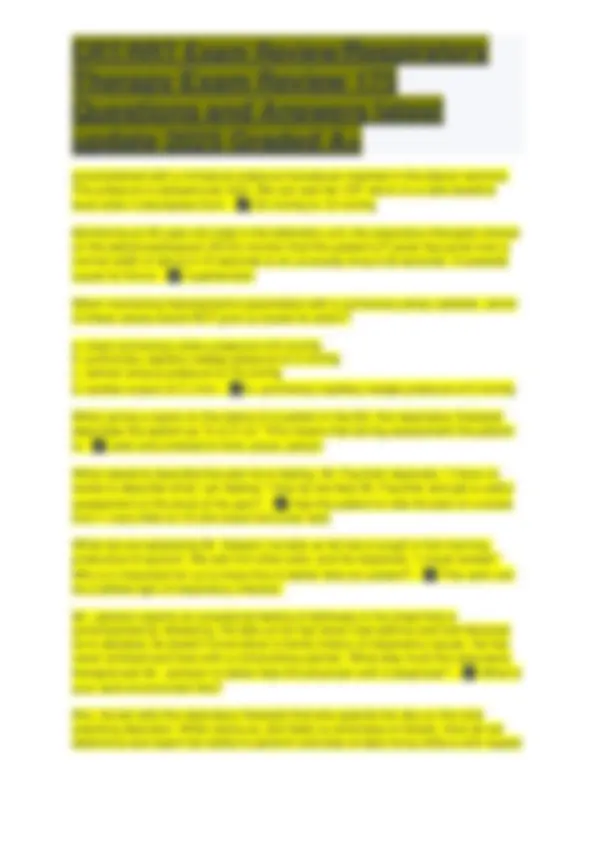
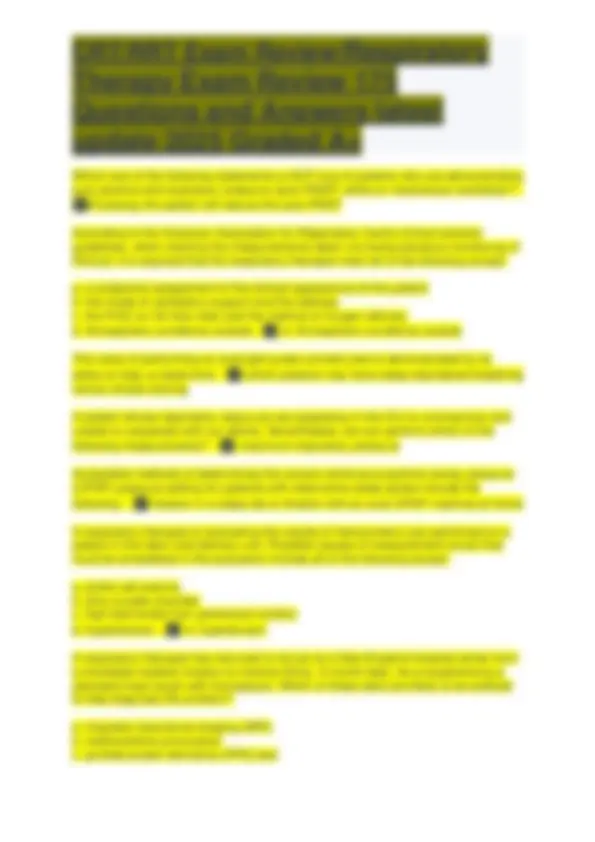
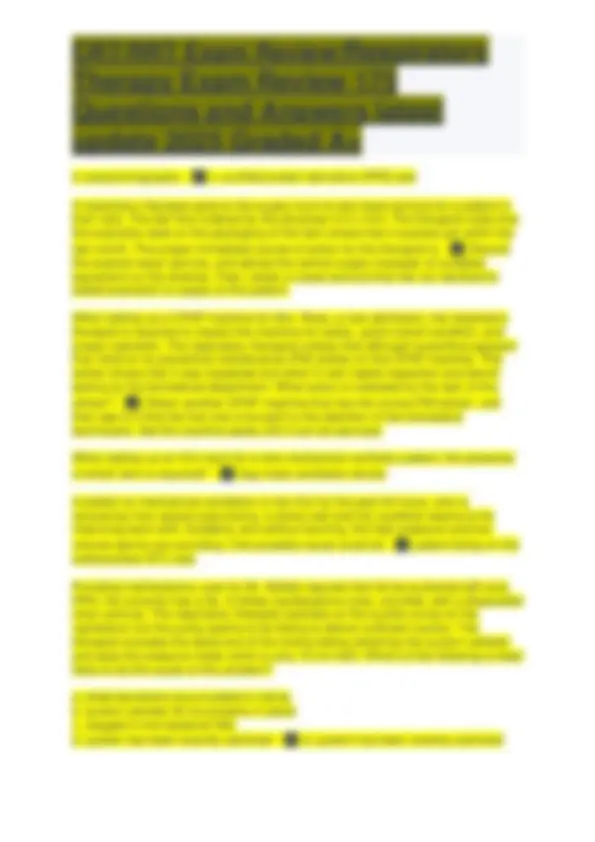
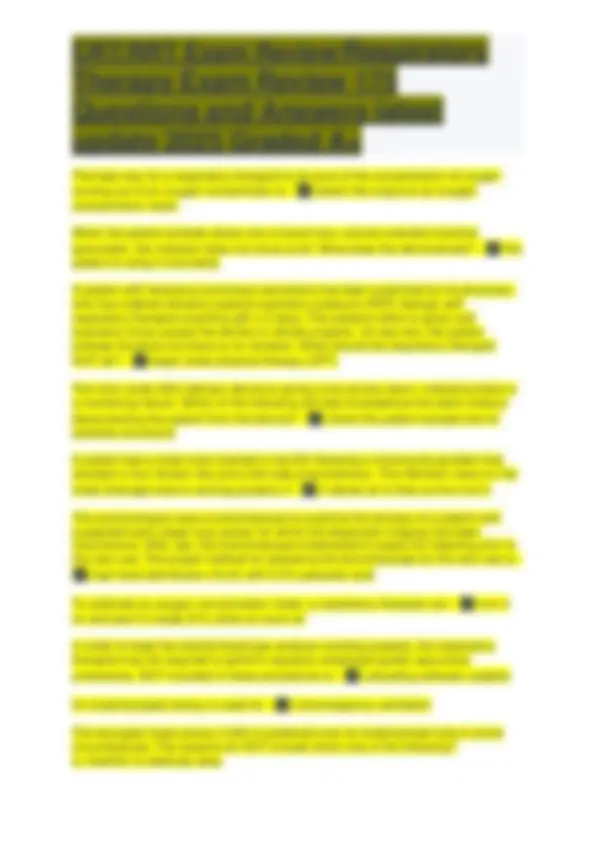
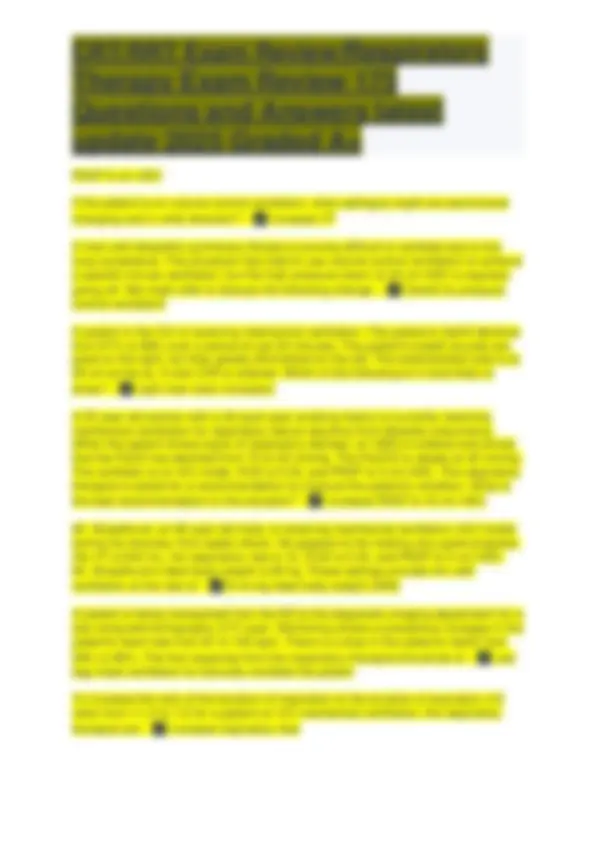
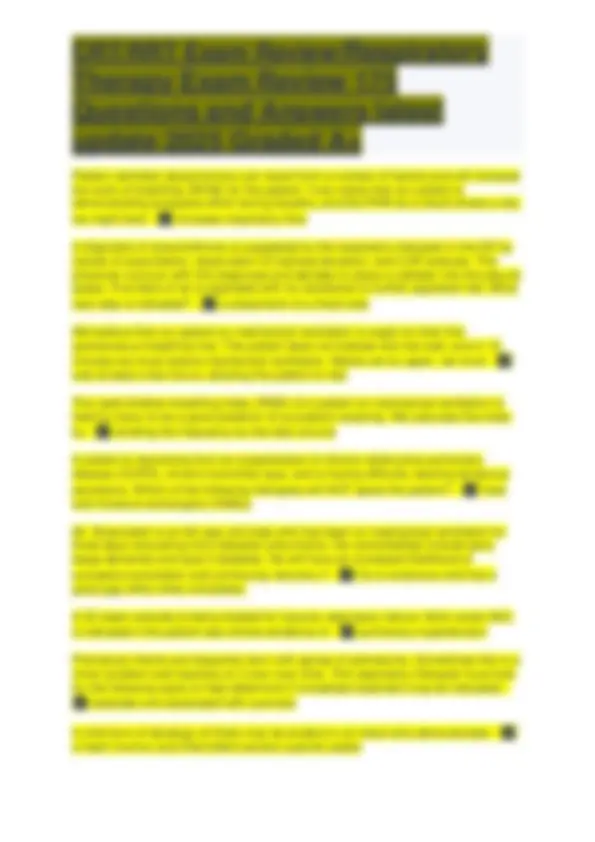
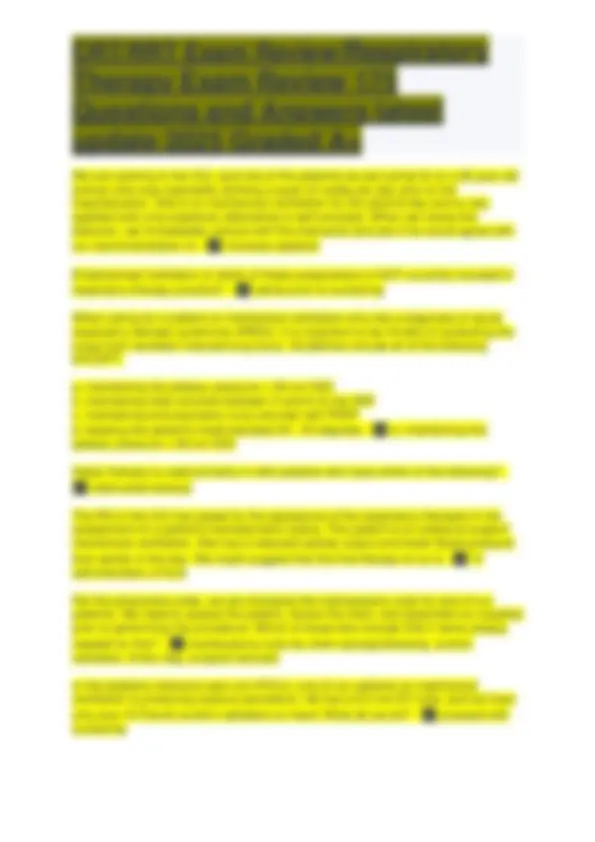
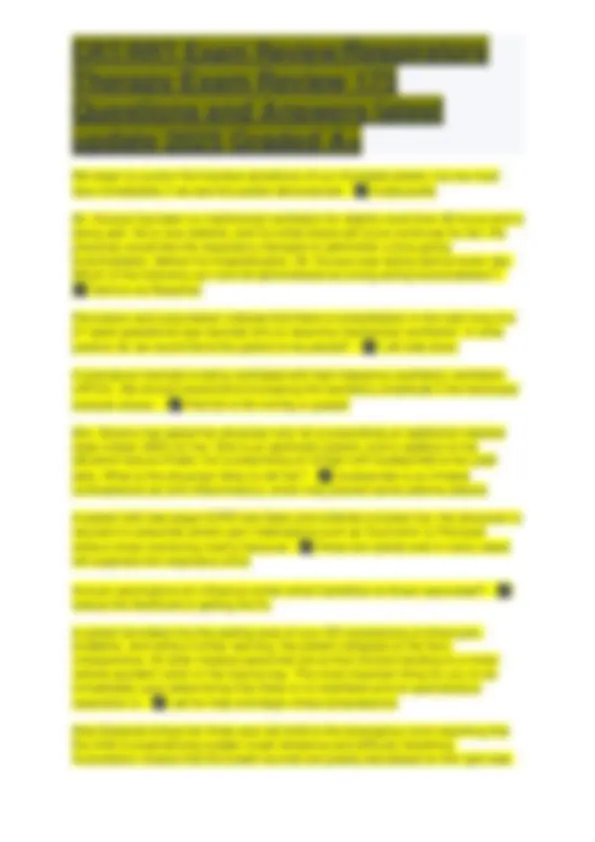
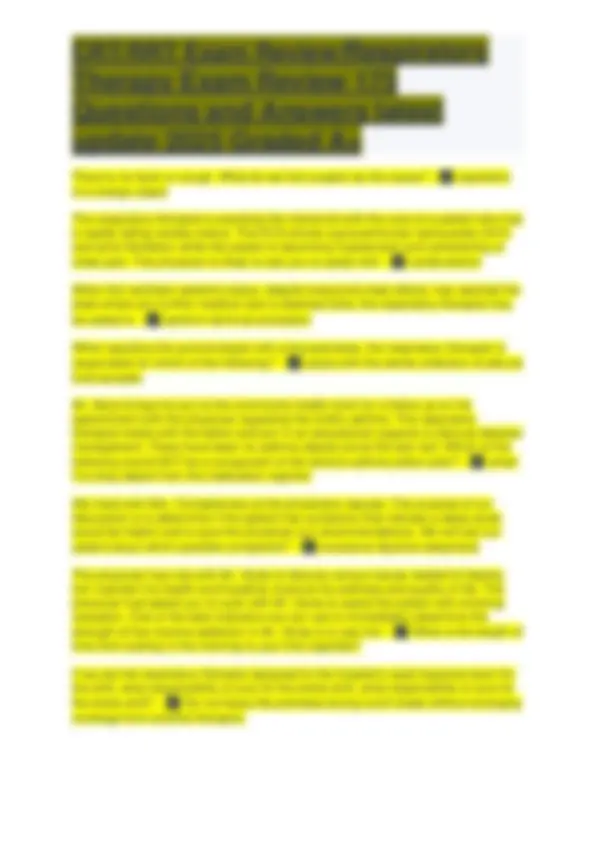



Study with the several resources on Docsity

Earn points by helping other students or get them with a premium plan


Prepare for your exams
Study with the several resources on Docsity

Earn points to download
Earn points by helping other students or get them with a premium plan
Community
Ask the community for help and clear up your study doubts
Discover the best universities in your country according to Docsity users
Free resources
Download our free guides on studying techniques, anxiety management strategies, and thesis advice from Docsity tutors
CRT-RRT Exam Review Respiratory Therapy Exam Review 175 Questions and Answers latest update 2025 Graded A+.pdf
Typology: Exams
1 / 23

This page cannot be seen from the preview
Don't miss anything!
















bleeding time (template) - ✅ less than 10 minutes erythrocyte count - ✅ 4.2 - 5.9 million/mcl erythrocyte sedimentation rate (Westergren) - ✅ Male: 0-15mm/hr Female: 0-20 mm/hr hematocrit, blood - ✅ Male: 42-50% Female: 40 - 48% hemoglobin, blood - ✅ Male: 13-16 g/dl Female: 12-15 g/dl leukocyte count and differential - ✅ leukocyte count: 4000- 1 1000/mcl 50 - 70% segmented neutrophils 0 - 5% band forms, 0-3% eosinophils 0 - 1% basophils, 30-45% lymphocytes 0 - 6% monocytes mean corpuscular volume - ✅ 86 - 98 fL protrhombin time, plasma - ✅ 11 - 13 seconds partial thromboplastin time (activated) - ✅ 30 - 40 seconds platelet count - ✅ 150,000 - 300,000/mcL reticulocyte count - ✅ 0.5 - 1.5% of red cells amylase, serum - ✅ 25 - 125 U/L
arterial studies, blood (Patient breathing room air): PO2 - ✅ 75 - 100 mmHg arterial studies, blood (Patient breathing room air): PCO2 - ✅ 38 - 42mmHg arterial studies, blood (Patient breathing room air): Bicarbonate - ✅ 23 - 26 mEq/L arterial studies, blood (Patient breathing room air): pH - ✅ 7.38 - 7. arterial studies, blood (Patient breathing room air): Oxygen Saturation - ✅ 95% or greater bicarbonate, serum - ✅ 23 - 28 mEq/L bilirubin, serum: - ✅ Total 0.3 - 1.0 mg/dL Direct 0.1 - 0.3 mg/dL Comprehensive metabolic panel: Bilirubin, serum (total) - ✅ 0.3 - 1.0 mg/dL Comprehensive metabolic panel: calcium, serum - ✅ Male: 9.0 - 10.5mg/dL Female: 8.5 - 10.2mg/dL Comprehensive metabolic panel: cholesterol, serum (total) - ✅ Desirable: less than 200md/dL Borderline-high: 200-239mg/dL(may be high in the presence of coronary artery disease or other risk factors) High: greater than 239md/dL Comprehensive metabolic panel: creatinine, serum - ✅ 0.7-1.5 mg/dL Glucose, plasma - ✅ Normal (fasting); 70 - 115 mg/dL Borderline: 115-140 mg/dL Abnormal: greater than 140 mg/dL phosphorus, serum - ✅ 3.0 - 4.5 mg/dL Proteins, serum: Pre-Albumin - ✅ 0.2 - 0.4 g/dL
Upon review of the patient record, the respiratory therapist notices that the chart indicates that the patient has a code status of "Do Not Resuscitate." During a routine assessment, the patient becomes apneic. Which of these should the respiratory therapist do? - ✅ Report this to the charge nurse as soon as possible. A review of physician orders for a patient admitted to an acute care facility with an exacerbation of chronic obstructive pulmonary disease (COPD) shows that the medications responsibility to perform which of these actions? - ✅ Contact the ordering physician to verify orders. Upon having difficulty getting a reading with the finger probe of a pulse oximeter, the respiratory therapist decides to check the patient's peripheral circulation and capillary refill. The nail bed on the right index finger, after a brief compression, becomes pink again after one second. This is an indication of which of the following? - ✅ normal peripheral circulation and capillary refill A 20-year old female patient is brought to the emergency department (ED) by paramedics after suffering a brief loss of consciousness after a collision with another player on the basketball court. Upon arrival, the patient's SpO2 is 98% on room air, her respiratory rate is 16, and her heart rate is 95. The venous blood draw shows that hemoglobin is 11.0 and hematocrit is 44. How do you report these findings? - ✅ Patient is saturating well on room air and has a normal heart rate and respiratory. Hemoglobin is low at 11.0 , and hematocrit is within normal limits. The first patient we see today for an evaluation is a 45-year old female who started smoking cigarettes at age 15. She reports that she smokes one and half packs a day and that she quit for a year when she was pregnant with each or her two children. Her husband is also a smoker. How do you report this smoking history in the patient chart? - ✅ Patient is currently a daily cigarette smoker, 1.5 packs per day, with a 42 pack-year history When introducing herself to a patient for the first time, the respiratory therapist notices that the patient is only able to respond to questions in two-or-three-word phrases, breaking up longer responses to take breaths after every couple of words. What conclusions can the respiratory therapist safely make from this speech pattern? - ✅ The patient has a decreased vital capacity, and there could be several different causes for this. Auscultation of breath sounds during an examination of a 20-year-old male reveals high-pitched wheezing throughout the lung field. The patient reports that he is slightly short of breath and that the wheezing, though noticeable, bothers him very little. He
notices that it usually happens when he mows the lawn. Which of the following might we recommend to the physician? - ✅ The patient's respiratory health is uncertain and would be better understood by performing basic spirometry and a methacholine challenge test. A 50-year old female patient presents with a three month history of cough productive of sputum that is more acute in the morning upon waking. The sputum is moderate in consistency, pale yellow in color, and varies from small to moderate in quantity. There is no fever or recent sick contacts. Auscultation reveals scattered rhonchi bilaterally, mostly in the lower lobes. The patient has no smoking history. What do you recommend? - ✅ A more complete history including vocation, exposure to environmental hazards, and family history is required. Also, PFTs are indicated for this patient with a pre- and post-bronchodilator FEV1/FVC. A patient presents to the ED of your hospital with productive cough, fever, and bilateral rhonchi in the lower lobes. The CXR shows possible bilateral infiltrate, according to the radiologist. To confirm a diagnosis of pneumonia, what level of white blood cells (WBCs) would we expect to find per microliter (mcL)? - ✅ 12,000 to 14,000 WBCs/mcL While performing routine care on a patient with a tracheostomy, you notice that there are traces of blood apparent on the dressing between the stoma and the flange of the tube. Which of these is the correct course of action? - ✅ Clean the area of the stoma with normal saline; do a careful inspection of the condition of the stoma; replace the old dressing with a new, clean dressing; carefully note your observation in the patient chart; and directly notify the unit manager that the stoma needs the attention of the patient's physician or advanced practice registered nurse (APRN) when one of them next does rounds. A patient brought into ED by paramedics from a car accident is unconscious and appears to have possibly suffered a chest wall injury. The physician orders an arterial blood gas (ABG) analysis (on room air). The results come back as follows: pH 7. PaCo2 58 mmHg PaO2 84 mmHg HCO3 24 mEq/L - ✅ stat CXR and possible noninvasive positive pressure ventilation (NIPPV) A patient in your care has appropriate tidal volumes; clear bilateral breath sounds throughout his lung fields; normal CBC; no signs or symptoms of infection; and although he is on a venturi mask delivering an FiO2 of 0.45, he has an SpO2 of 87%. The patient chart shows a history of a clotting disorder, although he is not currently
A 35 year old female patient is brought into the ED by her family. They suspect she may have taken an overdose of heroin. The physician wants to check for possible hypoventilation as a result of a suppressed respiratory drive and orders an ABG. In what order do we perform these steps? - ✅ Check for written order, check patient ID, perform Allen's test, wash hands, glove, prepare ABG draw kit, clean site with alcohol swab, draw sample Which of the following conditions in a patient chart might cause you to suspect that the SPO2 reading from a pulse oximeter might not be accurate for a particular patient? - ✅ The patient is a smoker who stepped out for a cigarette immediately before the examination. The pulmonologist has ordered bedside spirometry for a patient on his service. The patient is a 29 year old male smoker admitted through the ED after a diagnosis was made of ethanol toxicity. The patient is 183 cm tall, Caucasian, and weighs 105 kg. Three trials yield the following results for FVC and FEV1: 4.70 L/4.00 L - 5.67 L/4.66 L - 4.01 L/3.96 L The Centers for Disease Control and Prevention's Third National Health and Nutrition Examination Survey (NHANES III) predicted value is 5.84 L/4.75 L. What should the respiratory therapist report to the physician? - ✅ Inconsistent patient effort precludes useful analysis. Your patient is an 18 year old recent immigrant from the Philippines. Due to findings on the patient's CXR and the symptoms he presented with upon initial examination, the physician has given the patient a tentative diagnosis of tuberculosis and has admitted the patient to the hospital, ordering additional tests and appropriate isolation precautions. Which personal protective equipment (PPE) must we use during contact with this patient? - ✅ N95 mask, gown, gloves A 14 year old African American female with a diagnosis of asthma has, with your guidance and assistance, prepared an asthma action plan. Her daily peak flow measurements are recorded each morning. What results would indicate she is in the "yellow zone" and needs to use her inhaler according to the plan? - ✅ a peak flow reading 25% lower than her best Pulmonary function testing should be postponed for all of the following patients except: a. 71 year old male, status/post cerebrovascular accident (CVA) one week b. 17 year old female, recent CXR showing right sided pneumothorax c. 33 year old female, two broken ribs from a fall three days ago
d. 15 year old male, recent respiratory infection - ✅ d During the analysis of the flow volume curve of a patient's pulmonary function testing, we suspect that the patient may have coughed during the first second of exhale during one of the trials. What indicator would we see in the graph to lead to this conclusion? - ✅ a jagged interruption or dip in the curve during exhale The physician has asked us to evaluate the respiratory status of a patient with muscular dystrophy. Of all the tests that we may use in this assessment, which one should be performed first? a. maximum inspiratory pressure (MIP) b. maximal voluntary ventilation (MVV) c. arterial blood gas (ABG) d. CXR - ✅ a When examining the flow time graph of Mr. LaGuardia's pulmonary function test, we see that the line noticeably declines toward the baseline after reaching a plateau. What does this indicate? - ✅ a likely leak in the circuit The physician has asked for assistance in diagnosing a patient with moderate respiratory distress, a productive cough, and a fever. The patient coughs and expectorates sputum, which should always be examined for which characteristics? - ✅ culture When ABG results reveal that the patient is alkalotic, although she is apparently breathing normally, a possible cause is - ✅ repeated vomiting A patient in the telemetry unit is on continuous monitoring for, among other vital signs, SpO2. The patient has no signs of hypoxemia or respiratory distress but is now setting off an alarm when the SpO2 reading dips to 80% on 28% O2 via nasal cannula. A stat ABG shows a PaO2 of 85 mmHg. What course of action is indicated?
accomplished with a miniature pressure transducer inserted in the lateral ventricle. The pressure is dangerously high. We can see her ICP return to a safe baseline level when it decreases from - ✅ 20 mmHg to 10 mmHg Monitoring an 80 year old male in the telemetry unit, the respiratory therapist notices on the electrocardiogram (ECG) monitor that the patient's P wave has gone from a normal width of about 0.10 seconds to an unusually long 0.20 seconds. A possible cause for this is - ✅ hypertension When monitoring hemodynamic parameters with a pulmonary artery catheter, which of these values would NOT give us cause for alarm? a. mean pulmonary artery pressure of 8 mmHg b. pulmonary capillary wedge pressure of 5 mmHg c. central venous pressure of 18 mmHg d. cardiac output of 2 L/min - ✅ b. pulmonary capillary wedge pressure of 5 mmHg When giving a report on the status of a patient in the ED, the respiratory therapist describes the patient as "A & O x3." This means that during assessment the patient is - ✅ alert and oriented to time, place, person When asked to describe the pain he is feeling, Mr. Faucher responds, "I have no words to describe what I am feeling." How do we help Mr. Faucher and get a useful assessment of the level of his pain? - ✅ Ask the patient to rate his pain on a scale from 1 (very little) to 10 (the worst he's ever had) While we are assessing Mr. Salaam, he tells us he has a cough in the morning, productive of sputum. We ask him what color, and he responds, "I never looked." Why is it important for us to know this to better help our patient? - ✅ The color can be a telltale sign of respiratory infection. Mr. Jackson reports an occasional feeling of tightness in his chest that is accompanied by wheezing. He tells us he has never had asthma and that because he is adopted, he doesn't know about a family history of respiratory issues. He has never smoked and lives with a nonsmoking partner. What else must the respiratory therapist ask Mr. Jackson to better help the physician with a diagnosis? - ✅ What is your work environment like? Mrs. Hunter tells the respiratory therapist that she spends her day on the sofa watching television. When doing so, she feels no shortness of breath. How do we determine and report her ability to perform activities of daily living (ADLs) with regard
to dyspnea? - ✅ We ask her questions about toileting, meal preparation, and simple housework. During an evaluation of a 37 year old female patient who presents with a cough of unknown etiology, which family and personal history question is most relevant? a. Do you drink? b. Do you have family history of renal failure. c. Do you live with smokers? d. Do you have any food allergies? - ✅ c. Do you live with smokers? Tracheal deviation from midline will occur with which of these pairs of disorders? - ✅ pneumothorax and hemothorax Lateral neck radiographs can assist with the diagnosis of which acute condition? a. bronchitis b. respiratory syncytial virus c. croup d. pertussis - ✅ c. croup Proper patient positioning in a CXR will yield an image that includes all of the following except: a. lung apices b. costophrenic angles c. hemidiaphragms d. hyoid - ✅ d. hyoid The presence of pleural effusions will be seen in the CXR as - ✅ a light area at the lung base, at the costophrenic angle The difference between an anterior/posterior (A/P) CXR and a posterior/anterior (P/A) CXR is - ✅ In an A/P CXR, the heart appears larger A portable CXR shows an elevated hemidiaphragm on the right side. The most common reason this is seen is - ✅ enlarged liver resulting from cirrhosis The 12 lead EKG is widely used because - ✅ it is noninvasive and painless. A respiratory therapist can determine minute ventilation by first measuring - ✅ tidal volume and respiratory rate
Which one of the following statements is NOT true of patients who are demonstrating auto positive end-expiratory pressure (auto-PEEP) while on mechanical ventilation? - ✅Diuresing the patient will reduce the auto-PEEP According to the American Association for Respiratory Care's clinical practice guidelines, when charting the measurements taken via transcutaneous monitoring of PtcCo2, it is required that the respiratory therapist chart all of the following except: a. a subjective assessment of the clinical appearance of the patient b. the mode of ventilatory support and the settings c. the FiO2 (or O2 flow rate) and the method of oxygen delivery d. Atmospheric conditions outside - ✅ d. Atmospheric conditions outside The value of performing an overnight pulse oximetry test is demonstrated by its ability to help us determine - ✅ which patients may have sleep-disordered breathing versus simple snoring A patient whose respiratory status we are assessing in the ICU is unconscious and unable to cooperate with our efforts. Nevertheless, we can perform which of the following measurements? - ✅ maximum inspiratory pressure Acceptable methods of determining the correct continuous positive airway pressure (CPAP) pressure setting for patients with obstructive sleep apnea include the following: - ✅ titration in a sleep lab or titration with an auto-CPAP machine at home A respiratory therapist is evaluating the results of hemoximetry just performed on a patient in the labor and delivery unit. Possible causes of measurement errors that must be considered in the evaluation include all of the following except: a. sickle cell anemia b. dirty cuvette chamber c. high lipid levels from parenteral nutrition d. hypertension - ✅ d. hypertension A respiratory therapist has returned to his job at a New England hospital center from a charitable medical mission to Central Africa. A month later, he is experiencing a persistent bad cough with hemoptysis. Which of these tests are likely to be ordered to help diagnose the problem? a. magnetic resonance imaging (MRI) b. methacholine provocation c. purified protein derivative (PPD) test
d. polysomnography - ✅ c. purified protein derivative (PPD) test A respiratory therapist goes to the supply room to get nasal cannula for a patient in their care. The liter flow ordered by the physician is 2 L/min. The therapist notes that the expiration date on the packaging of the item shows that it expired just within the last month. The proper immediate course of action for the therapist is - ✅ Discard the expired nasal cannula, and advise the central supply manager of outdated equipment on the shelves. Then, obtain a nasal cannula that has not reached its stated expiration to supply to this patient. When setting up a CPAP machine for Mrs. Rose, a new admission, the respiratory therapist is required to inspect the machine for safety, good overall condition, and proper operation. The respiratory therapist notices that although everything appears fine, there is no preventive maintenance (PM) sticker on the CPAP machine. This sticker shows that it was inspected and when it next needs inspection and bench testing by the biomedical department. What action is indicated by the lack of this sticker? - ✅ Obtain another CPAP machine that has the correct PM sticker, and then see to it that the first one is brought to the attention of the biomedical technicians. Set the machine aside until it can be serviced. When setting up an ICU room for a new mechanical ventilator patient, the presence of which item is required? - ✅ bag mask ventilation device A patient on mechanical ventilation in the ICU for the past 24 hours, who is recovering from severe pneumonia, is doing well and her condition seems to be improving each shift. Suddenly and without warning, the high-pressure and low- volume alarms are sounding. One possible cause could be - ✅ patient biting on the endotracheal (ET) tube Providing tracheostomy care for Mr. Bollela requires that he be suctioned q2h plus PRN. He currently has a No. 6 Shiley tracheostomy tube, uncuffed, with a disposable inner cannula. The respiratory therapist switches on the suction pump on the nightstand, but the pump seems to be failing to deliver sufficient suction. The therapist occludes the distal end of the tubing before attaching the suction catheter and sees the pressure meter climb to only 10 cm H2O. Which of the following is least likely to be the cause of this problem? a. dried secretions accumulated in tubing b. suction canister lid not properly in place c. clogged in line bacterial filter d. system has been recently sterilized - ✅ d. system has been recently sterilized
b. placement requires no equipment c. it avoids tracheal and laryngeal trauma d. materials are always hypoallergenic - ✅ d. Materials are always hypoallergenic Mr. Shimizu has a tracheostomy tube in place for six weeks now since his surgery for laryngeal cancer. He may begin to use a speaking valve on his tube, which will enable him to do which of the following? - ✅ inhale through his tracheostomy tube and exhale through his trachea and oropharynx Prevention of ventilator associated pneumonia (VAP) is achieved by observing certain protocols and procedures. Which of the following will NOT help reduce the risk of VAP? a. incline the head of the bed to 30 to 45 degrees b. provide oral care c. spontaneous breathing test daily d. timely administration of albuterol or DuoNeb - ✅ d. timely administration of albuterol or DuoNeb Ms. Kwame has passed her spontaneous breathing trials and is ready for extubation. What are the steps for extubation, and in what order are the steps performed? - ✅ Suction, oxygenate, deflate cuff, remove tube, supplemental O2 (if indicated), assess patient The physician who is attending to Mr. Borinkov's respiratory infection wants to evaluate the patient for nasotracheal suctioning to determine if it is indicated and safe. Which of the following is not contraindications for this procedure? a. myocardial infarction b. acute facial or neck injury c. coagulopathy or bleeding disorder d. age over 65 - ✅ d. age over 65 One of the possible complications that a respiratory therapist might encounter while performing postural drainage is acute hypotension during the procedure. Which of the following describes the appropriate steps to take? - ✅ stop therapy, return patient to the original resting position, and consult the physician High frequency chest wall oscillation (vest therapy) is a fundamental component of secretion clearance for patients with which of the following? - ✅ cystic fibrosis Incentive spirometry has been ordered for Miss Fontana to assist with her recovery from abdominal surgery. The goal of this therapy is to help prevent - ✅ atelectasis
In the ambulance on his way from the scene of a domestic violence incident, a young man is receiving supplemental O2 at a flow rate of 2 L/min via simple mask. His SpO2 on arrival at teh ED is 97%. While the trauma team is evaluating injuries sustained by the patient, the respiratory therapist might best recommend - ✅ switching the patient to 2 L/min via nasal cannula One of the patients in the skilled nursing facility where you work has been having trouble becoming accustomed to her newly ordered CPAP machine. The prescribed therapy is 10cm H2O of pressure with humidity. The main complaint, which is becoming an impediment to compliance, is that the full face mask is making the patient feel claustrophobic. What is the best thing a respiratory therapist can do to assist this patient? - ✅ offer to supply the patient with a smaller mask such as a nasal mask or nasal pillows Acute respiratory failure requiring mechanical ventilation can be the result of all the following EXCEPT: a. sepsis b. Opiate overdose c. Left sided heart failure d. Pneumonia - ✅ c. left sided heart failure Which of the following sets of decisions must be made before, or at the time of, initiating mechanical ventilation? - ✅ invasive vs. noninvasive, mode of ventilation, FiO2, rate, PEEP Why is pressure controlled ventilation preferred in some situations? - ✅ improved gas distribution allows for lower VT High frequency ventilation is sometimes used on pediatric and neonatal patients. A typical high frequency setting is - ✅ 900 breaths per minute We are caring for a critically ill patient who is on mechanical ventilation. The ABG results are as follows: pH 7. PaCO2 46 torr PaO2 70 torr HCO3 24 mEq/L BE - 1 mEq/L Mode Volume Control rate 14 FiO2 0. VT 500 mL
Patient ventilator dyssynchrony can result from a number of factors and will increase the work of breathing (WOB) for the patient. If we notice that our patient is demonstrating excessive effort during breaths, and the PAW as a result shows a dip, we might best - ✅ increase respiratory flow A diagnosis of pneumothorax is suggested by the respiratory therapist in the ED by results of auscultation, observation of tracheal deviation, and CXR analysis. The physician concurs with this diagnosis and decides to place a catheter into the pleural space. Five liters of air is aspirated with no resistance to further aspiration felt. What next step is indicated? - ✅ a placement of a chest tube We believe that our patient on mechanical ventilation is ready for their first spontaneous breathing trial. The patient does not tolerate this trial well, and in 15 minutes we must restore mechanical ventilation. Before we try again, we must - ✅ wait at least a few hours, allowing the patient to rest The rapid shallow breathing index (RSBI) of a patient on mechanical ventilation is held by many to be a good predictor of successful weaning. We calculate the index by - ✅ dividing the frequency by the tidal volume A patient is recovering from an exacerbation of chronic obstructive pulmonary disease (COPD), chronic bronchitis type, and is having difficulty clearing tenacious secretions. Which of the following therapies will NOT assist the patient? - ✅ heat and moisture exchangers (HMEs) Mr. Brownstein is an 84 year old male who has been on mechanical ventilation for three days recovering from bibasilar pneumonia. His comorbidities include early stage dementia and type 2 diabetes. He will have an increased likelihood of successful extubation and continuing recovery if - ✅ he is conscious and has a good gag reflex when extubated. A 32 week neonate is being treated for hypoxic respiratory failure. Nitric oxide (NO) is indicated if the patient also shows evidence of - ✅ pulmonary hypertension Premature infants are frequently born with apnea of prematurity. Sometimes this is a minor problem and resolves on it own over time. The respiratory therapist must look for the following signs to help determine if immediate treatment may be indicated: - ✅ episodes are associated with cyanosis A mild form of tetralogy of Fallot may be evident in an infant who demonstrates - ✅ a heart murmur and intermittent severe cyanotic spells
We are working in the ICU, and one of the patients we are caring for is a 28 year old woman who was reportedly drinking a quart of vodka per day prior to her hospitalization. She is on mechanical ventilation for the second day and is very agitated and unsuccessfully attempting to self extubate. When we notice this behavior, we immediately consult with the intensivist and ask if he would agree with our recommendation to - ✅ increase sedation Endotracheal instillation of which of these preparations is NOT currently included in respiratory therapy practice? - ✅ saline prior to suctioning When caring for a patient on mechanical ventilation who has a diagnosis of acute respiratory distress syndrome (ARDS), it is important to be mindful of protecting the lungs from ventilator induced lung injury. Guidelines include all of the following EXCEPT: a. maintaining the plateau pressure > 28 cm H2O b. maintaining tidal volumes between 4 and 8 mL/kg IBW c. maintaining end expiratory lung volumes with PEEP d. keeping the patient's head elevated 30 - 45 degrees - ✅ a. maintaining the plateau pressure > 28 cm H2O Heliox therapy is used primarily in with patients who have which of the following? - ✅ obstructed airways The RN in the ICU has asked for the assistance of the respiratory therapist in the assessment of a patient's hemodynamic status. The patient is on pressure support mechanical ventilation. She has a reduced cardiac output and lower blood pressure than earlier in the day. We might suggest that the first therapy to try is - ✅ IV administration of fluid Per the physicians order, we are changing the tracheostomy tube for one of our patients. We need to assess the patient, review the chart, and assemble our supplies prior to performing the procedure. Which of these lists include ONLY items always needed for this? - ✅ tracheostomy tube tie, drain sponge/dressing, suction catheters, Ambu bag, surgical lubricant In the pediatric intensive care unit (PICU), one of our patients on mechanical ventilation is producing copious secretions. He has a 6.0 mm ET tube, and we have only size 10 French suction catheters on hand. What do we do? - ✅ proceed with suctioning